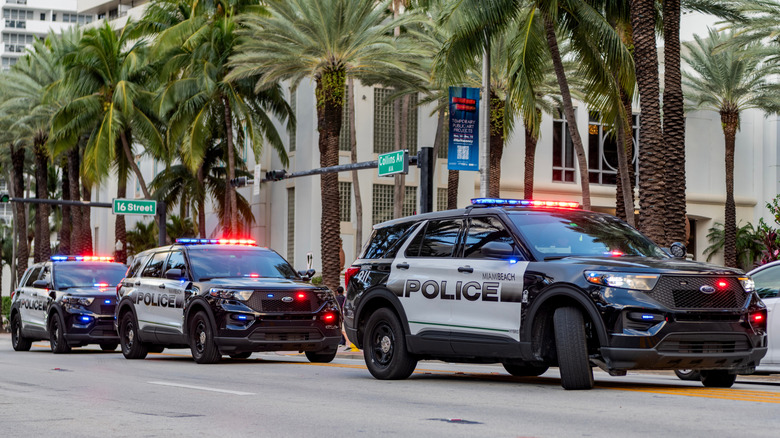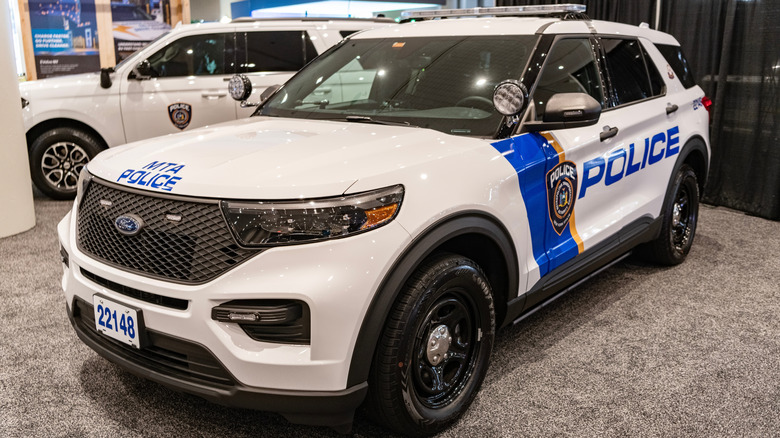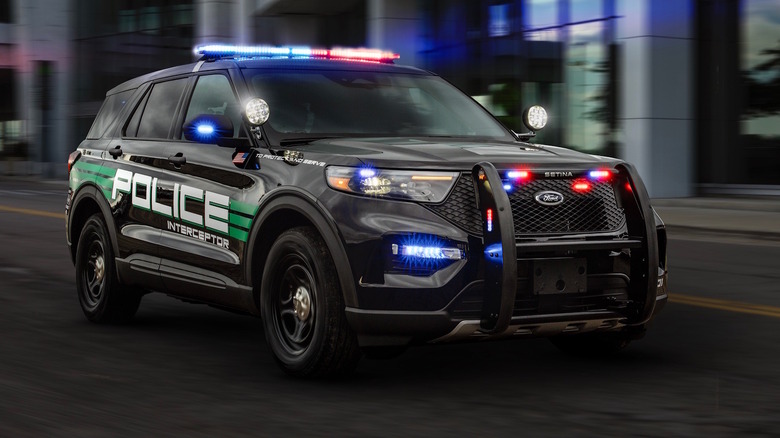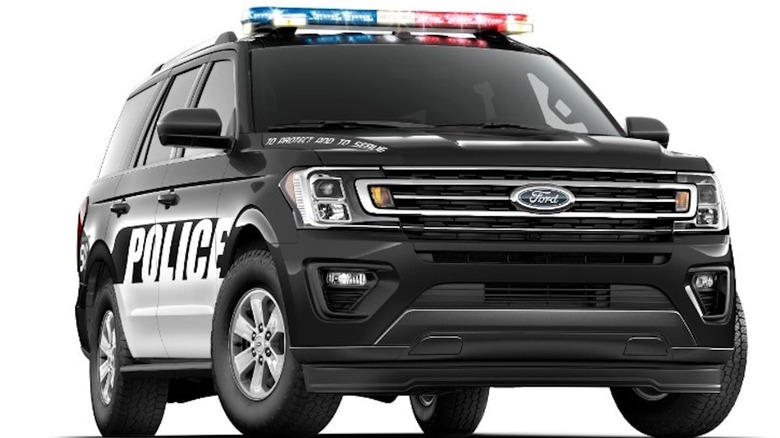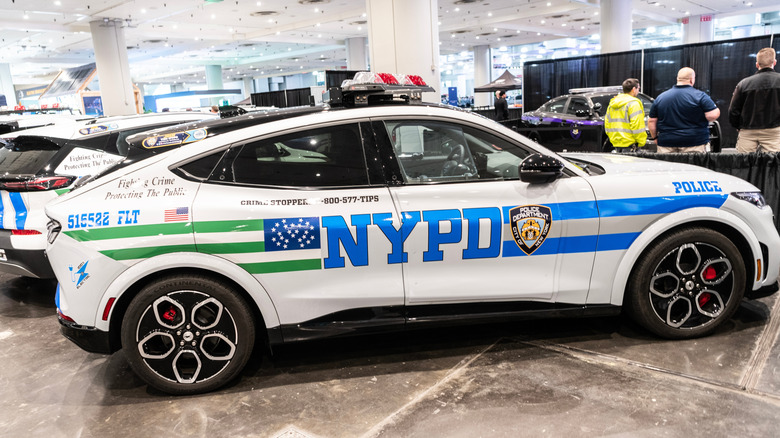Which Ford SUV Do Police Use In North America? (And How Fast Can It Go?)
Police vehicle sales have been a small but impactful part of Ford's business. The Blue Oval and law enforcement go back over a hundred years, with the Oakland, California, Police Department among the first agencies to standardize their fleet under one brand. By the 1950s, the automaker began offering a specialized package that made street vehicles better suited for the rigors of police work.
Ford's police cars have always mirrored the models sold to the public. The LTD Crown Victoria entered agency work in the early 1980s, transitioning to the Crown Victoria as the model became its own nameplate in 1992. The departure of the "Crown Vic" from Ford's lineup after 2012 saw the Ford Taurus take over patrol duties. The company's decision to mostly abandon passenger vehicle production (except the Mustang) meant Ford police vehicles would take on an SUV configuration after the 2019 departure of the Taurus from the lineup.
Today, the Ford police vehicle most likely to appear in your rearview mirror is the Explorer, which is dubbed the Police Interceptor Utility when configured for law enforcement. The company also makes the Expedition Special Service Vehicle (SSV), and the Mustang Mach-E is making its way into departments.
Police Interceptor Utility: More than a Ford Explorer
According to government-fleet.com, the Ford Police Interceptor Utility (PIU) is the "best-selling" police vehicle in the U.S. In base form, the PIU features a 318-horsepower 3.3-liter V6 hybrid powerplant. Ford's marketing literature mentions that the PIU is "the only pursuit-rated hybrid police utility vehicle." So, the cops can chase the bad guys and save fuel at the same time. During 2024 testing by the Michigan State Police (MSP), the Ford Police Interceptor Utility Hybrid had an average zero-to-60 time of 6.99 seconds. This Ford SUV is EPA-rated for 24 mpg combined.
Ford makes other versions of the PIU. For agencies that don't need hybrid efficiency and power, there's a standard version of the 3.3-liter V6, which makes 285 hp. The MSP reports this edition needs 7.64 seconds to reach 60 mph. The quickest Police Interceptor Utility has a twin-turbocharged 3.0-liter V6 under the hood. It produces 400 hp, enabling this variant to reach 60 mph in 5.81 seconds, based on MSP testing. According to Ford, both PIU editions with the 3.3-liter V6 have a top speed of 136 mph, while the twin-turbo 3.0-liter can reach 148 mph. All PIU variants have all-wheel drive and a ten-speed automatic transmission.
Making a Ford Explorer ready for police duty
In promoting the PIU to law enforcement customers, Ford emphasizes how this SUV differs from the civilian Explorer. Notably, the PIU is engineered to withstand a 75-mph rear impact to protect the fuel tank and hybrid battery system. Federal standards require a 50 mph standard for consumer-purchased vehicles. While some ordinary cars get a "sport" mode to adjust shift points and throttle control, the PIU has a steering-wheel-mounted "Pursuit" mode button for rapid activation. In addition, the PIU has only two rows of seating, unlike the three-row civilian Explorer.
Keeping the unique needs of police work in mind, Ford has added other features to the PIU that aren't found in family-friendly Explorers. An idle function lets the vehicle's engine to run without worrying about unauthorized use. The system offers emergency lighting, communication devices, and other equipment to operate with the key removed. When surveillance and discretion are the priority, Dark Car Mode can turn off all interior lighting. Police Perimeter Alert uses the blind-spot monitoring system to check for threats approaching the vehicle. Upon determining a potential hazard, the system activates a warning sound, engages the rearview camera, rolls up the windows, and locks the doors.
A Ford Expedition gets to wear a badge
While the Explorer-based Police Interceptor Utility represents the bulk of Ford's specialized sales to law enforcement, the company has outfitted an Expedition to help keep law and order. The Expedition SSV comes in two- or three-row configurations. Ford police vehicles wearing the SSV badge aren't pursuit-rated like the PIU and are built for less demanding requirements. The 2025 Expedition SSV has a twin-turbo 3.5-liter V6 found in the civilian versions of the Expedition. There are no published zero-to-60 mph times for the Expedition SSV, but the civilian version with a higher output engine (440 horsepower) has been clocked at making this dash in 5.1 seconds.
This police-ready Ford SUV shares several features with the latest version of the retail Expedition, including a larger center touchscreen and a split tailgate. In SSV guise, it gets Dark Car Mode from the PIU, a system that limits access to the cargo area, and a beefier electrical system to support accessory police gear.
A police-focused Ford Mustang Mach-E
Ford has dipped its toe into policing and EVs with the Mustang Mach-E GT. A 2022 edition became the first EV to pass MSP testing for high-speed pursuit and other police-centric metrics. In 2024 testing, the agency put a Mustang Mach-E through its passes. In GT trim form, the example—with 480 hp and all-wheel drive—reached 60 mph from zero in 4.07 seconds and a top speed of 124 miles per hour.
It's still early for Mustang Mach-Es to report for duty like the PIU and Expedition SSV. Ford is calling it a "supporting vehicle," a category it assigns to models that haven't reached pursuit-rated or SSV status but hopes agencies will purchase for less demanding requirements. The Michigan State Police announced in January that it's piloting a Mach-E for general patrol duties around state buildings. New York's Finest also hopped on board earlier and more aggressively. In 2023, the NYPD added dozens of Mustang Mach-E units to its fleet.
